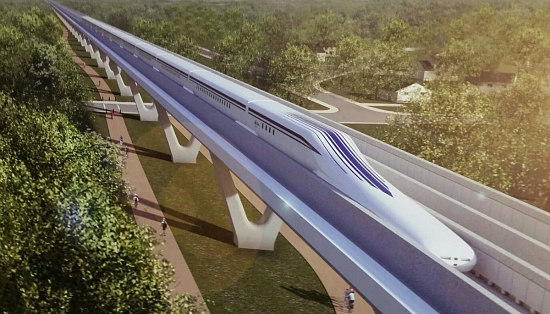What's Hot: Nearly $1 Million An Acre: Pricey Land Sale Near Dan Snyder's Alexandria Home Closes Out 2025
 What Will Be the First High-Speed Travel Option in the DC Region?
What Will Be the First High-Speed Travel Option in the DC Region?
✉️ Want to forward this article? Click here.
While the Metrorail system still struggles to secure dedicated funding and ensure reliable service — and construction on the Purple Line is underway — local jurisdictions also have their eyes on a bigger prize: modernized, high-speed travel that would connect DC to other major cities on the East Coast. Here are the three separate proposals in the works to bring high-speed travel to the DC region.
Southeast High Speed Rail Corridor
Years ago, an idea was floated for a high-speed rail service that would extend from Atlanta to New York, stopping in other major cities on the East Coast along the way. The plans for the leg of travel from Richmond to DC involve modernizing existing tracks, and laying new tracks in some areas, to allow for high-speed travel up to 95 miles per hour (mph), 16 mph faster than the current maximum of 79.
Virginia is in the final phase of analyzing the potential to move forward on a connection traversing the 127-mile stretch, holding meetings with stakeholders last month and wrapping up an environmental study. “The real issue is, CSX owns that track, and quite frankly, where they are in their corporate structure right now is they don’t want a lot more infrastructure to maintain,” Virginia Secretary of Transportation Aubrey Layne explained at a regional transportation panel held earlier this week.
In the meantime, the restoration or replacement of the Long Bridge railroad bridge between DC and Virginia will likely inform how Virginia proceeds with their high-speed rail plans. A final decision on how to proceed with high speed rail here is expected to come in early 2019, with the goal of adding several high-speed rail trips to the corridor by 2045.
story continues below
loading...story continues above

The Boring Company’s Hyperloop
Despite a Trump advisor acknowledging earlier this week that he may have inadvertently implied federal approval of the proposed transit system, Maryland still seems eager to see the Hyperloop come to fruition.
The Hyperloop concept is about as futuristic as mass transportation models come. The technology involves small passenger pods coursing through a tunnel using electric propulsion and magnetic levitation at up to 700 mph.
“I believe that even high-speed rail is going to become obsolete with the development — and I know this sounds like science fiction — [of] the Hyperloop technology, which is much less expensive than high-speed rail and will provide faster commuting between wherever you want to go,” Maryland Secretary of Transportation Pete Rahn stated at the recent transportation panel. Governor Larry Hogan has also given his enthusiastic approval to the Hyperloop, permitting the Boring Company to begin utility work and tunneling along a portion of 295 near Fort Meade last month.

Superconducting Magnetic Levitation
Maryland is also proceeding with plans to deliver a Superconducting Magnetic Levitation train that would connect DC to Baltimore and, eventually, to New York. Magnetic levitation (maglev) is a technology already being employed in other cities worldwide, wherein superconducting magnets running along the bottom of the train and the guideway propel the train forward without friction, travelling up to hundreds of miles per hour.
With a potential route that runs alongside Amtrak no longer on the table, the local route will likely go from Mount Vernon Square or NoMA to BWI Airport, concluding its route in Westport, Port Covington or the Inner Harbor in Baltimore, with tunnels parallel to the Baltimore-Washington Parkway. However, that route may be a little congested with the Hyperloop already boring its way along 295.
Ultimately, mid-2019 is the target date for getting a final route approved, allowing the design phase to commence and, potentially, the system to break ground that same year. If completed, the maglev railway would transport people between DC and Baltimore in 15 minutes. Former Amtrak president Joseph Boardman also once expressed a desire to see travel times from DC to New York City decline from 162 minutes to 96 minutes by 2040.
See other articles related to: elon musk, high-speed trains, hyperloop, maglev, train
This article originally published at http://dc.urbanturf.production.logicbrush.com/articles/blog/what_will_be_first_high-speed_travel_option_in_the_dc_region/13265.
Most Popular... This Week • Last 30 Days • Ever

With frigid weather hitting the region, these tips are important for homeowners to ke... read »

Today, UrbanTurf offers a brief explanation of what it means to lock in an interest r... read »

The 30,000 square-foot home along the Potomac River sold at auction on Thursday night... read »

An application extending approval of Friendship Center, a 310-unit development along ... read »

A key approval could be coming for a proposal to convert a Georgetown office building... read »
DC Real Estate Guides
Short guides to navigating the DC-area real estate market
We've collected all our helpful guides for buying, selling and renting in and around Washington, DC in one place. Start browsing below!
First-Timer Primers
Intro guides for first-time home buyers
Unique Spaces
Awesome and unusual real estate from across the DC Metro













